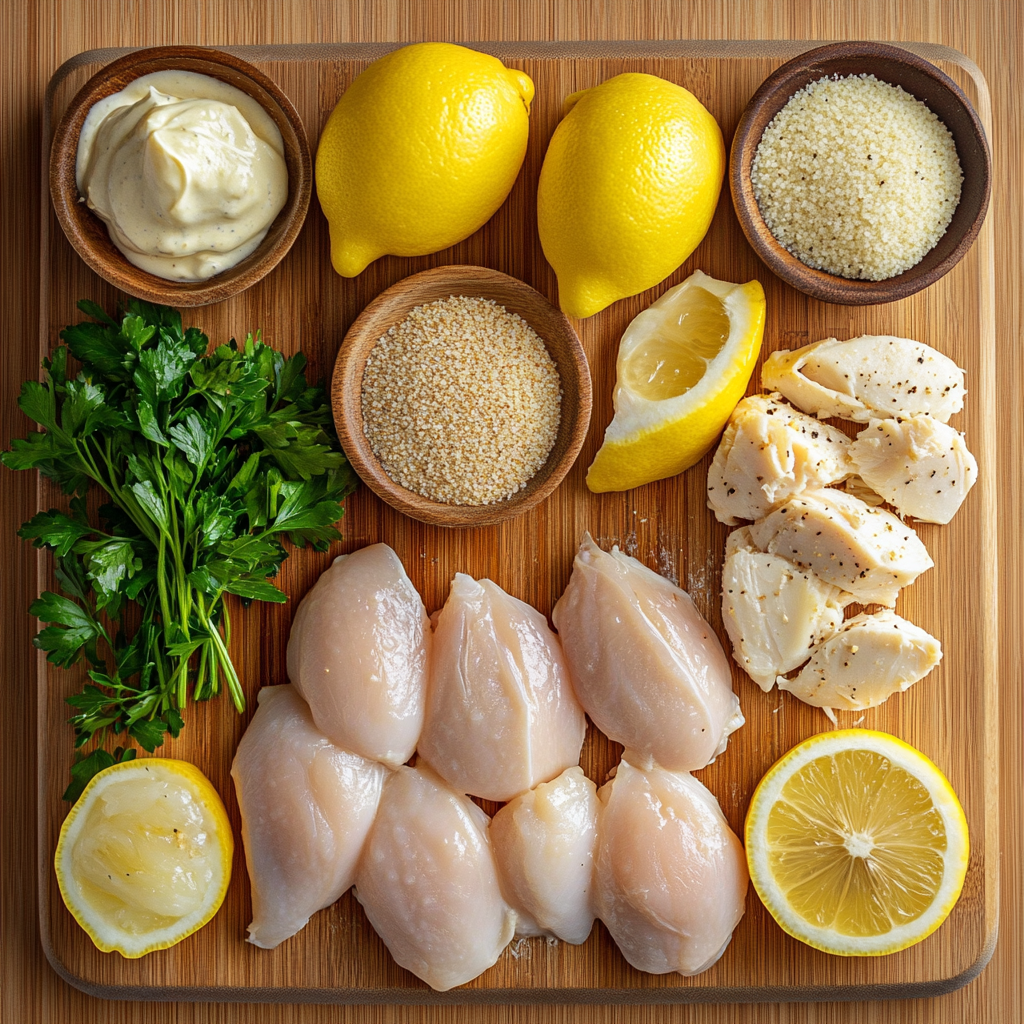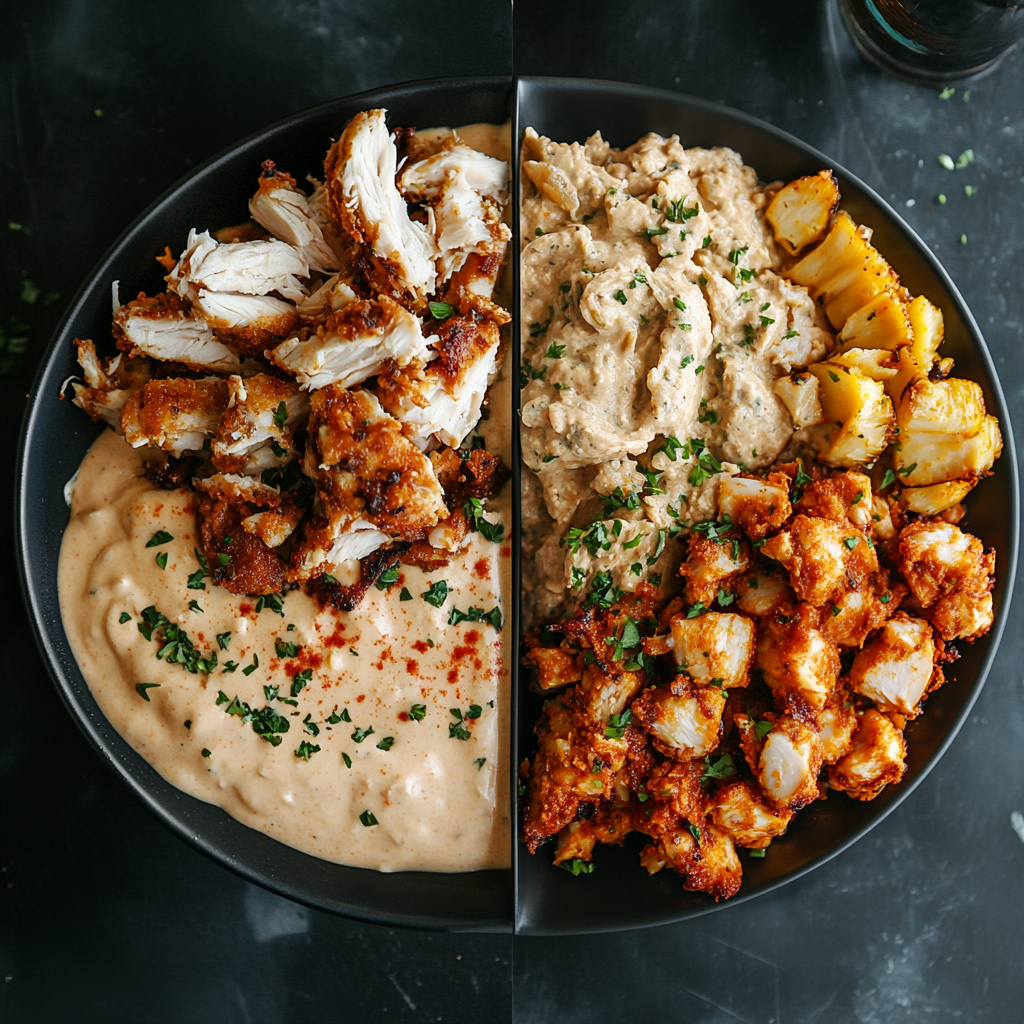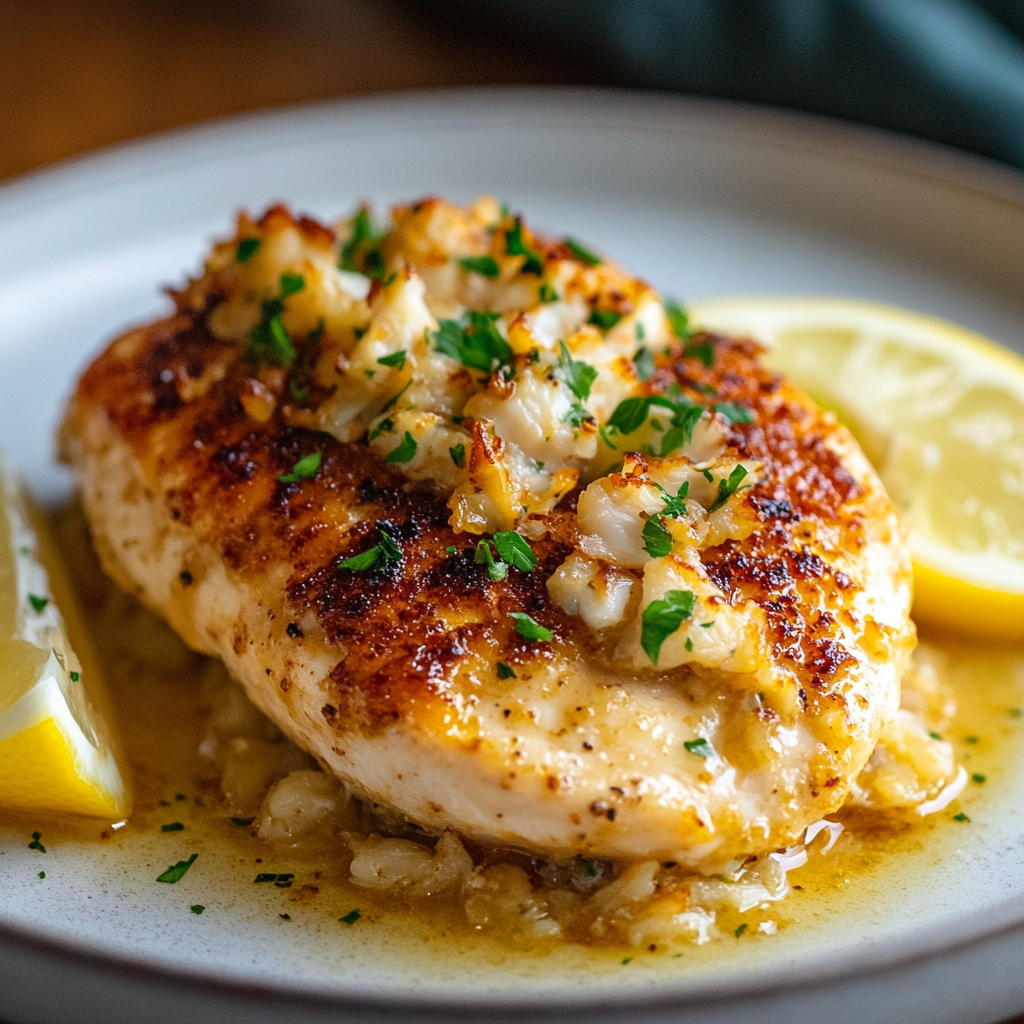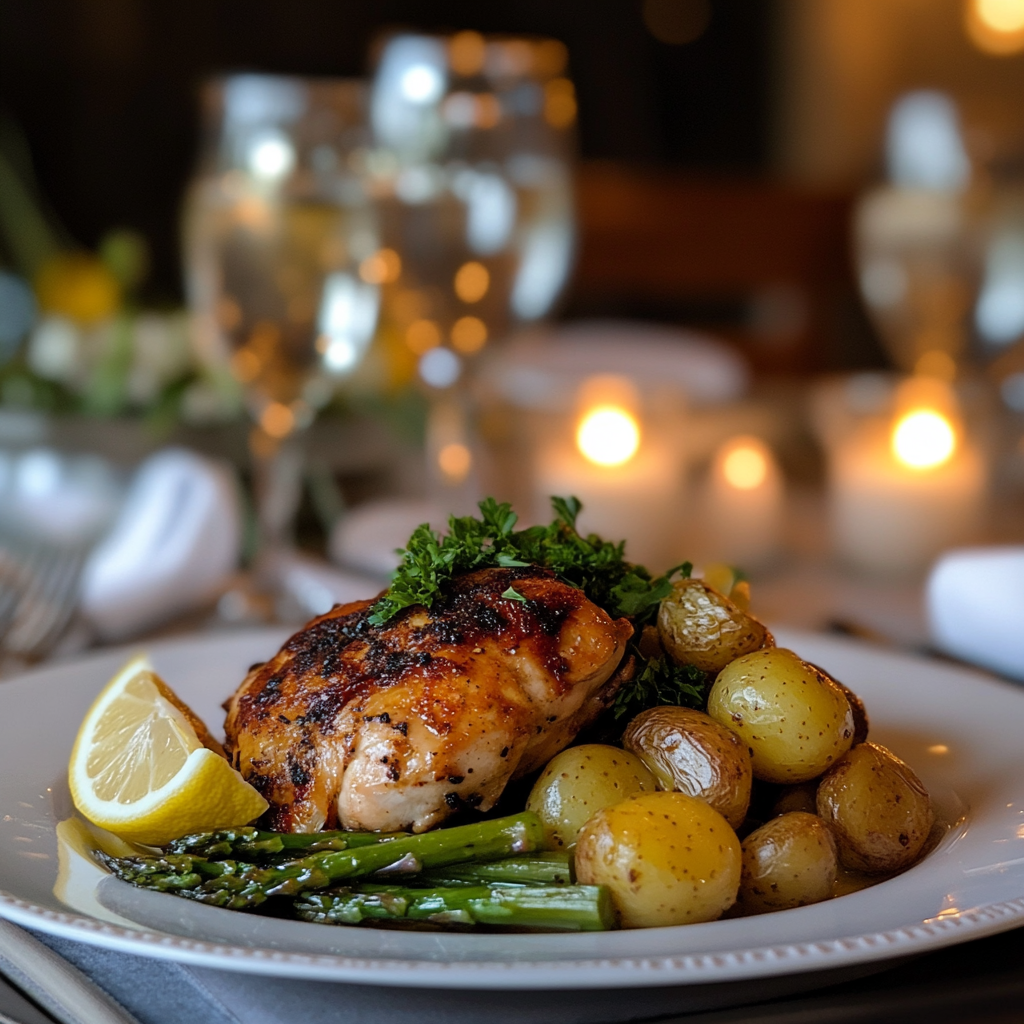When it comes to combining the best of both worlds — succulent chicken and flavorful crabmeat — there’s no dish quite like Chicken Chesapeake. This Maryland-inspired recipe takes a classic chicken breast and elevates it with a rich, creamy crab mixture, seasoned perfectly with the state’s signature Old Bay seasoning. Whether you’re a seafood lover or a fan of hearty chicken dishes, this recipe satisfies all taste buds. Plus, it’s versatile enough to fit any occasion, whether it’s a quick family dinner or an elegant weekend meal.
For more meal ideas that are quick, delicious, and perfect for everyday use, explore our extensive Dinner section.
Ingredients for Chicken Chesapeake Recipe and Possible Substitutions
The key to a delicious Chicken Chesapeake recipe lies in the balance of flavors from both the chicken and the crab. Below is the list of ingredients you’ll need to bring this savory dish to life. What’s great about this recipe is its flexibility; it’s easy to make substitutions to accommodate dietary preferences or ingredient availability.
Main Ingredients:
- 4 boneless, skinless chicken breasts – Opt for free-range or organic chicken for the best quality and flavor. If you’re looking for a leaner alternative, turkey breasts can also work beautifully in this recipe. For a quicker version, you can also use chicken thighs, but keep in mind they may take a little longer to cook.
- 8 oz jumbo lump crabmeat – Fresh jumbo lump crabmeat is the star of this dish. If you don’t have access to fresh crab, high-quality canned crab or even imitation crabmeat works as a more affordable alternative. Just be sure to drain canned crab well before using.
- 1/2 cup mayonnaise – This helps bind the crab mixture together while adding richness. For a lighter version, you can swap mayonnaise with Greek yogurt. Greek yogurt gives the dish a tangier flavor but still maintains the creamy texture.
- 1/4 cup Dijon mustard – This adds a nice sharpness and tang to balance out the rich crab mixture. Yellow mustard can be used in a pinch but will yield a slightly different flavor.
- 1 tsp Old Bay seasoning – No Chesapeake-style dish is complete without this iconic spice blend. If you don’t have Old Bay on hand, a combination of celery salt, paprika, cayenne pepper, and ground mustard can make for a decent homemade version.
- 1/4 cup grated Parmesan cheese – While optional, Parmesan adds a delightful nutty, savory note to the crab mixture. For a dairy-free option, nutritional yeast is a great substitute that still provides a cheesy flavor.
- 1 tbsp lemon juice – The acidity from lemon juice brightens the dish and complements the seafood perfectly. Freshly squeezed lemon is recommended, but bottled lemon juice works in a pinch.
- 1 tbsp fresh parsley (chopped) – This adds freshness and color to the dish. You can also use cilantro or basil for a different herbaceous twist.
- 1 tsp garlic powder – Garlic powder is used for a subtle garlic flavor that won’t overpower the crab. You can also use fresh garlic, finely minced, for a more robust garlic flavor.
Ingredient Substitutions for Different Dietary Needs:
- Gluten-Free: Ensure all your ingredients, especially the mayonnaise and mustard, are certified gluten-free. The good news is that this recipe is naturally gluten-free when you skip the sandwich bun.
- Low-Carb: To make this dish keto-friendly or low-carb, simply omit any breading or buns if making a sandwich variation. You can also swap mayonnaise for avocado oil mayonnaise for fewer carbs and added healthy fats.
- Dairy-Free: Substitute the Parmesan cheese with a dairy-free alternative like nutritional yeast or dairy-free shredded cheese. Also, ensure the mayonnaise used is dairy-free.
Looking for more inspiration for gluten-free or low-carb meals? Check out our Snacks section for recipes that can be enjoyed alongside your Chicken Chesapeake.

Essential Kitchen Tools for Chicken Chesapeake and Their Alternatives
No kitchen is complete without the proper tools to create culinary masterpieces like Chicken Chesapeake. While this dish doesn’t require any fancy gadgets, a few essential kitchen tools will make your cooking experience smoother. However, don’t worry if you don’t have every tool on hand—there are easy substitutions for most items.
Tools You’ll Need:
- Oven-safe skillet or cast-iron pan – An oven-safe skillet is essential for searing the chicken breasts on the stovetop before transferring them to the oven for finishing. Cast-iron skillets are ideal because they retain heat well, ensuring even cooking. If you don’t have a cast-iron pan, any oven-safe skillet or sauté pan will work.
- Mixing bowl – You’ll need a medium-sized mixing bowl to combine the crab mixture ingredients. If you prefer not to dirty another dish, you can mix the ingredients in the crabmeat container as long as it’s large enough.
- Tongs – Tongs are perfect for flipping the chicken breasts without piercing them, which helps retain their juices. If you don’t have tongs, a sturdy spatula or fork will do the job, but be careful not to lose those precious juices!
- Aluminum foil – Useful for covering the skillet when baking to keep the chicken moist and prevent the crab topping from drying out. You can also use an oven-safe lid if your skillet comes with one.
- Meat thermometer – While not strictly necessary, a meat thermometer is highly recommended to ensure your chicken is cooked through but not overdone. Chicken should reach an internal temperature of 165°F (75°C) to be safe for consumption. If you don’t have a thermometer, cutting into the chicken to check for doneness is a viable alternative, though less precise.
Tool Substitutions:
- Cast-Iron Pan: If you don’t have a cast-iron skillet, a heavy-duty nonstick pan can work just as well. However, you may need to finish cooking the chicken on a baking sheet if your pan isn’t oven-safe.
- Meat Thermometer: If you’re without a meat thermometer, you can tell if chicken is done by cutting into the thickest part of the breast. It should be white throughout with no pink spots and clear juices.
For more recipes that make use of these essential kitchen tools, explore our Dinner category.
Step-by-Step Instructions for Making Chicken Chesapeake
Now that you have all your ingredients and tools ready, it’s time to bring everything together and create the perfect Chicken Chesapeake dish. Don’t worry if you’re not an experienced cook — these step-by-step instructions will guide you through each part of the process, ensuring a delicious result even for beginners.
Step 1: Preheat the Oven
Start by preheating your oven to 375°F (190°C). While the oven heats up, gather all your ingredients and tools to ensure everything is ready for smooth cooking.
Step 2: Season the Chicken
Pat the chicken breasts dry with paper towels, then season both sides generously with salt, pepper, and a pinch of Old Bay seasoning. You want to season the chicken well because this is the base flavor for the dish.
Step 3: Sear the Chicken
Heat your oven-safe skillet over medium heat and add a tablespoon of olive oil. Once the oil is hot and shimmering, place the chicken breasts in the skillet and sear them for 4-5 minutes on each side, or until the chicken develops a golden-brown crust. Searing the chicken locks in its juices and creates a flavorful crust.
Step 4: Transfer to the Oven
Once both sides of the chicken are nicely seared, transfer the skillet to the preheated oven. Let the chicken cook for another 15-20 minutes or until it reaches an internal temperature of 165°F (75°C). This ensures that your chicken will be fully cooked and juicy.
Step 5: Prepare the Crab Topping
While the chicken is in the oven, it’s time to prepare the crab topping. In a medium mixing bowl, combine the jumbo lump crabmeat, mayonnaise, Dijon mustard, lemon juice, Old Bay seasoning, grated Parmesan cheese, and a pinch of salt and pepper. Stir everything together gently to avoid breaking up the crab too much.
Step 6: Top the Chicken with Crab Mixture
Once the chicken reaches an internal temperature of 165°F, remove it from the oven and carefully top each breast with a generous portion of the crab mixture. Spread the mixture evenly over the chicken, making sure to cover it completely.
Step 7: Bake Again
Return the skillet to the oven and bake the chicken with the crab topping for another 5-7 minutes. This step allows the crab topping to warm through and develop a slight golden-brown color.
Step 8: Garnish and Serve
Once the chicken is done, remove the skillet from the oven and garnish the dish with freshly chopped parsley and a wedge of lemon on the side. Serve immediately for the best flavor.
For similar recipes with this stovetop-to-oven cooking method, check out our delicious Breakfast dishes.
Flavor Variations for Chicken Chesapeake to Suit Any Taste
One of the most exciting aspects of Chicken Chesapeake is how adaptable it is to suit various flavor preferences, dietary needs, and even seasonal ingredients. Whether you want to make the dish lighter, more decadent, or entirely plant-based, there are numerous ways to customize it without compromising on flavor. Here are some delicious flavor variations to try:
Low-Carb Chicken Chesapeake
For those following a low-carb or keto diet, Chicken Chesapeake is already a great option due to its high protein and healthy fat content. To make the dish even more keto-friendly:
- Skip the sandwich bun entirely, and serve the chicken on a bed of steamed vegetables such as broccoli, spinach, or green beans.
- You can also replace the mayonnaise with avocado oil mayonnaise, which contains fewer carbs and is packed with healthy fats.
- Pair this low-carb version with a creamy cauliflower mash or roasted Brussels sprouts for a satisfying, low-carb side dish.
Vegan Chicken Chesapeake
Yes, you can even make a vegan version of Chicken Chesapeake! Here’s how:
- Instead of chicken, use a plant-based chicken substitute like seitan or tofu. Be sure to season it generously with Old Bay to retain the Chesapeake flavors.
- For the crab topping, try using hearts of palm or artichoke hearts as a vegan alternative to crab. Combine it with a vegan mayonnaise and a touch of nutritional yeast for that cheesy flavor.
- You can also add seaweed flakes or dulse to the mix to give the vegan crab topping a briny, seafood-like taste.
Gluten-Free Chicken Chesapeake
If you need to make this dish gluten-free, you’re in luck! This recipe is naturally gluten-free, as long as you check that your mayonnaise, Dijon mustard, and Old Bay seasoning are certified gluten-free.
- For the sandwich version, opt for gluten-free buns or serve the chicken over a salad or gluten-free pasta.
- If you’re using breaded chicken breasts, make sure to use gluten-free breadcrumbs or crushed gluten-free crackers as a substitute.
Need more side dishes or meal pairings? Check out our Snacks section for more ideas that go perfectly with any variation of Chicken Chesapeake.

Expert Tips for Making the Best Chicken Chesapeake
Even though this recipe is straightforward, there are a few tips and tricks that can elevate your Chicken Chesapeake to the next level. Here are some pro tips to help you avoid common mistakes and ensure your dish turns out perfectly every time.
1. Don’t Overcook the Chicken
One of the most important factors in making a delicious Chicken Chesapeake is to avoid overcooking the chicken breasts. Overcooked chicken can become dry and tough, which will detract from the overall experience. Use a meat thermometer to monitor the internal temperature of the chicken, and remove it from the oven as soon as it reaches 165°F (75°C). If you don’t have a thermometer, cut into the thickest part of the breast; if the juices run clear and the meat is no longer pink, it’s done.
2. Use Fresh Crabmeat
Whenever possible, opt for fresh jumbo lump crabmeat. Fresh crabmeat has a sweeter, more delicate flavor that pairs beautifully with the chicken. However, if you can’t find fresh crab, you can use high-quality canned crab. Just make sure to drain it thoroughly and pick through it to remove any shell fragments. If you’re using imitation crab, note that it has a slightly different texture and flavor but can still work in a pinch.
3. Sear the Chicken for Maximum Flavor
Searing the chicken before finishing it in the oven is crucial for building flavor. The high heat creates a caramelized crust on the outside of the chicken, locking in its juices and giving the dish an added layer of texture. If you’re using a nonstick skillet, be sure not to crowd the pan; sear the chicken in batches if necessary to avoid steaming it.
4. Adjust the Crab Topping to Your Taste
The beauty of this recipe lies in its flexibility, so feel free to adjust the crab topping to suit your preferences. For a richer crab topping, you can add more Parmesan cheese or even a spoonful of cream cheese. If you prefer a lighter topping, reduce the mayonnaise and increase the lemon juice for a tangier, fresher flavor.
5. Garnish Like a Pro
Don’t underestimate the power of garnishes! Fresh herbs like parsley, cilantro, or even a spritz of lemon juice can brighten the flavors of the dish and make it look restaurant-quality. A sprinkle of extra Old Bay seasoning on top of the crab mixture can also give the dish a final burst of Chesapeake flavor.
Looking to master more advanced cooking techniques? Try another recipe from our Dinner category that focuses on professional methods and tips.

Nutritional Information: How Healthy Is Chicken Chesapeake?
While Chicken Chesapeake is an indulgent dish, it also packs plenty of nutritional benefits thanks to the combination of lean protein and seafood. Here’s a breakdown of what makes this dish both delicious and nutritious.
Calories:
A serving of Chicken Chesapeake typically contains around 400 calories, depending on portion size and ingredients used. This makes it a relatively balanced meal when paired with healthy sides like steamed vegetables or a fresh salad.
Protein:
Both chicken and crab are excellent sources of lean protein. A serving of Chicken Chesapeake offers around 40 grams of protein, which is essential for muscle growth, repair, and overall energy levels. Protein also helps keep you full and satisfied, making this dish a great choice for lunch or dinner.
Vitamins:
This dish is rich in several essential vitamins, particularly:
- Vitamin B12, which is found in crabmeat and plays a crucial role in maintaining healthy nerve function and red blood cell production.
- Niacin (Vitamin B3), which is found in chicken and supports metabolism and heart health.
Minerals:
In addition to being a good source of vitamins, Chicken Chesapeake also provides important minerals, such as:
- Calcium and phosphorus, which are necessary for maintaining strong bones and teeth.
- Zinc, found in crabmeat, which is vital for immune system function.
For a more detailed breakdown of the health benefits of crab and chicken, check out this trusted source on seafood nutrition.
Serving Suggestions for Chicken Chesapeake: Pairings and Sides
Chicken Chesapeake is a versatile dish that can be served in many ways depending on the occasion. Whether you’re making it for a cozy weeknight meal or a more formal gathering, these serving suggestions will help you create a balanced and complete meal.
Classic Style
For a traditional Chicken Chesapeake experience, serve the chicken with a side of roasted potatoes and steamed asparagus. The potatoes offer a hearty, comforting element, while the asparagus provides a fresh and slightly bitter contrast to the rich crab topping. You can also include a drizzle of lemon-butter sauce for an extra layer of flavor.
Chicken Chesapeake Sandwich
If you’re in the mood for something more casual, try turning this dish into a Chicken Chesapeake sandwich. Simply place the crab-topped chicken breast on a toasted brioche bun and add a dollop of tartar sauce or a squeeze of fresh lemon juice. This makes for a fantastic, Maryland-style sandwich that’s perfect for lunch or a quick dinner.
Fresh Salad Pairing
For a lighter meal, serve the chicken with a Caesar salad or coleslaw. The crispness of the salad balances out the richness of the chicken and crab, making for a well-rounded plate. You can also serve it with a simple green salad dressed with lemon vinaigrette for a refreshing contrast.
For more pairing ideas, visit our Dinner section, where we offer a wide range of side dishes and garnishes.

Storage and Reheating Tips for Chicken Chesapeake
If you have leftovers from your Chicken Chesapeake dinner (which is rare, because it’s so delicious!), you’ll want to know the best ways to store and reheat it so it retains all its flavor and texture. Here’s how you can store and reheat this dish to enjoy it again.
Refrigeration:
You can store Chicken Chesapeake in an airtight container in the refrigerator for up to 3 days. Be sure to place it in the fridge within 2 hours of cooking to maintain freshness and food safety. If you plan to eat the leftovers the next day, the dish should still be juicy and flavorful.
Freezing:
Yes, you can freeze Chicken Chesapeake! To freeze, allow the chicken to cool completely, then wrap each chicken breast tightly in aluminum foil or plastic wrap. Place the wrapped chicken in a freezer-safe container or a heavy-duty freezer bag. It will keep for up to 2 months in the freezer. For best results, thaw the chicken in the refrigerator overnight before reheating.
Reheating:
When reheating Chicken Chesapeake, it’s best to use the oven to prevent the chicken from drying out. Preheat your oven to 350°F (175°C) and bake the chicken for 10-12 minutes or until warmed through. If the chicken was frozen, allow it to thaw in the fridge overnight before reheating. You can also reheat in the microwave, though the texture of the crab topping may change slightly. To keep it from drying out, cover the chicken with a damp paper towel when reheating in the microwave.
FAQs About Chicken Chesapeake and Chesapeake Cuisine
What are some good recipes for preparing Dungeness crab?
Dungeness crab is incredibly versatile and can be used in dishes like crab cakes, crab bisque, or even a fresh crab salad. For more ideas on how to prepare Dungeness crab, check out our Dinner recipes featuring a variety of seafood options.
How to prepare canned lump crab meat?
Preparing canned lump crab meat is easy and convenient for those who don’t have access to fresh crab. Simply drain the canned crabmeat thoroughly and pick through it to remove any shell fragments. It can be used in crab cakes, seafood dips, or this Chicken Chesapeake recipe for a quick and affordable alternative to fresh crabmeat.
Is there any Chesapeake cuisine?
Yes! Chesapeake cuisine is strongly influenced by the seafood-rich waters of Maryland and Virginia. The region is known for its signature dishes like crab cakes, oysters, and Chicken Chesapeake. The defining flavors of Chesapeake cuisine often include Old Bay seasoning, lemon, and fresh seafood, all of which make for hearty and flavorful meals. Check out our Dinner section for more Chesapeake-inspired recipes.
Conclusion: Why You’ll Love This Chicken Chesapeake Recipe
In summary, Chicken Chesapeake is the perfect dish for those who love the combination of chicken and seafood. Its rich, creamy crab topping paired with succulent chicken breasts creates a mouthwatering meal that’s ideal for any occasion. Whether you’re preparing it for a special dinner or a casual weeknight meal, this versatile recipe is sure to impress.
For more inspiring recipes, take a look at our Dinner section, where you’ll find even more exciting dishes to try.
